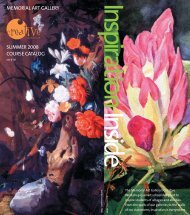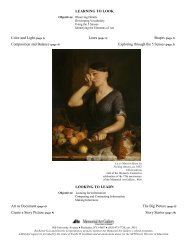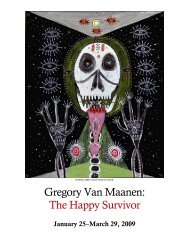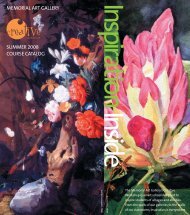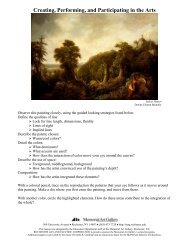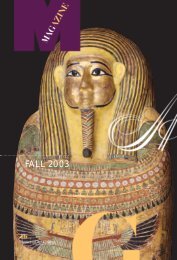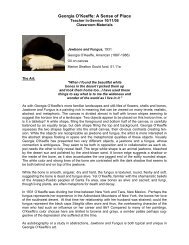Around the MAGKRISTIN DAVIESPreserved for EternitySo who is the man behind the golden mask?Thanks to an unusual collaboration withthe UR Medical Center, MAG curatorshave a new understanding <strong>of</strong> a 2,000-year-old mummy on loan from PeabodyEssex Museum in Salem, MA.While the mummy’s name and family connections remainlost to history, researchers using the latest computertomography (CT) scanning technology and forensicanthropology techniques have pieced together a new picture<strong>of</strong> the ancient Egyptian, whose remains were mummifiedsometime during the Roman era (30 CE to 330 CE).The mummy arrived at the <strong>Gallery</strong> in June 2003 to bepart <strong>of</strong> the new Gill Center exhibit Protected for Eternity:The C<strong>of</strong>fins <strong>of</strong> Pa-debehu-Aset. Wrapped in layers <strong>of</strong> linenand wearing a gold mask, he had recently been conservedby Mimi Leveque at Peabody Essex.First, however, he had a 90-minute appointment in thedepartment <strong>of</strong> radiology at Strong <strong>Memorial</strong> Hospital.Imaging procedures are notuncommon in the study <strong>of</strong>mummification—the PeabodyEssex mummy had, for example,been x-rayed and scannedin Salem about five years ago.But the technology is changingso rapidly that it was worthscanning the mummy again tosee if new details might emerge,says curator Nancy Norwood.The new scans—taken at intervals <strong>of</strong> just a few millimeters—haveallowed researchers to put together a highlydetailed digital image <strong>of</strong> the body and, in particular, theskull. From those images, Kristin Davies, an FBI-trainedforensic artist from the <strong>Rochester</strong> Police Department, wasable to project what the man may have lookedlike (below).The scans also confirmed that the mummywas undoubtedly a man, that he stood about5 feet, 6 inches tall, and that he was at thetime <strong>of</strong> his death between 20 and 30 years old. His teethare in excellent condition, indicating that he probablyenjoyed a somewhat comfortable upper middle-classlifestyle. And the condition <strong>of</strong> his bones give no indicationthat he died a violent death.“It’s fascinating to me that I can take everything I knowforensically and apply it to someone who is 2,000 years old,”says Jennifer Prutsman-Pfeiffer, a forensic anthropologist at13KRISTIN DAVIESStrong, who helped analyze thenew results. “I had to stop a coupletimes and think, ‘Wow, this guyis 2,000 years old.’”Nancy Norwood notes that thefocus <strong>of</strong> the exhibit is on thec<strong>of</strong>fins <strong>of</strong> Pa-debehu-Aset, acquired by the <strong>Gallery</strong> in2000. But even though the mummyhas no historical connection to the c<strong>of</strong>fins, his presencehelps round out the exhibition’s educational focus.“We wanted to emphasize that there’s a strong spiritualreason behind mummification,” Norwood says. “The mummyreally does emphasize the humanity <strong>of</strong> the process.”SCOTT HAUSERLearning to Look“It’s like deciphering a puzzle,” said one <strong>of</strong> ten youngphysicians participating in an unusual collaborationbetween MAG and UR Medical School.The ten, all residents in psychiatry, were learning to readvisual cues—a skill that would serve them equally welllooking at art and interacting with patients.They began by examiningan unnamed work,later revealed to beTavern Scene by 17thcenturyFlemish artistDavid Teniers theYounger. Led by SusanDaiss, the <strong>Gallery</strong>’sdirector <strong>of</strong> education,they inventoried theelements <strong>of</strong> the work,described what theythought they were seeing, guessed at time and place, andshared personal reactions. It was a slow, painstakingprocess, as the residents learned not to jump to conclusions,or (in medical terms) “premature closure.”In the case <strong>of</strong> the Teniers, it soon became clear thatthings aren’t always what they seem. As Daiss pointedout, a sketch pinned to the wall is not just for decoration.It shows an owl,with eyeglasses and candle, representinghis failure to see the folly <strong>of</strong> his ways.Formally titled “The <strong>Art</strong> <strong>of</strong> Observation,” the programbegan when Daiss’s phone rang in fall 2002. StephanieBrown Clark, an MD-PhD and an assistant pr<strong>of</strong>essor inthe department <strong>of</strong> medical humanities, had read about anintriguing collaboration between Yale Center for BritishJAMES M. VIA
Around the MAG<strong>Art</strong> and that university’s medical school. She and Daissimmediately set up a series <strong>of</strong> brainstorming sessions withBrown Clark’s medical colleague Jules Cohen, studentRachel Kowal, and MAG curator Nancy Norwood.Out <strong>of</strong> their discussions came an eight-week electivecourse for first-year students in spring 2003. “The <strong>Art</strong><strong>of</strong> Observation” alternated between the <strong>Gallery</strong>, wherethe 14 students looked at art, and the medical center,where they observed patients. In fall 2003 a new coursewas <strong>of</strong>fered for second-year students. This time thesessions were less general: portraits (reading expressionsand body language) were paired with psychiatry; signs<strong>of</strong> aging in works <strong>of</strong> art, with a visit to geriatric patientsat Monroe Community Hospital; looking at prints withlooking at pathology specimens.In addition to the courses and sessions for residents, theMAG-URMC team hosted all 100 new medical studentsduring orientation week; held an event for students’ familyand friends; and participated in seminars for high schoolbiology teachers and teens considering careers in medicine.“What we’ve developed on MAG’s end,” says Daiss, “is aversion <strong>of</strong> the same methodology that we use in helpingeveryone—from kindergarten students to docents—learnto look. And it was wonderful to have Stephanie as apartner in this process because she was always questingfor parallels. What she initially thought was concreteskill building turned out to be much more complex.And the complexity, I think she and I would agree, isin the nature <strong>of</strong> art itself—the essential humanity that’sembedded in these objects.”What started as an exploratory project is quickly growinginto a full-fledged program, one that recently acquired anew team member. Helping create a new course forspring 2005 is Hannah Solky, a physician who also happensto be one <strong>of</strong> 38 new MAG docents (page 4).RICHARD P. WERSINGERFrances brought torrential rains and flooding to the alreadysoggy <strong>Rochester</strong> area. At MAG, contractors had to waituntil Friday afternoon before they could lay down a makeshiftaccess road along the back <strong>of</strong> the <strong>Gallery</strong> property.Without it, artists and food service venders could not haveaccessed the food tents and parking areas. As it was, thecontractors couldn’t even begin the project—which consisted<strong>of</strong> a moisture barrier and several tons <strong>of</strong> crushedgravel—until water levels began to recede.Armed with straw and mulch, MAG employees workedtirelessly before and during the weekend trying to controlgroundwater and mud. In spite <strong>of</strong> their efforts, threeartists unloading near their booths needed tow truckson Friday evening, and the rig erecting the beer tent gottemporarily enmired in the mud.In the end, though, the hard work paid <strong>of</strong>f and theevent went <strong>of</strong>f without a hitch. That was good news forthe <strong>Gallery</strong>, which counts Clothesline as its biggest fundraiser,and for M&T Bank, which was underwritingthe event for an unprecedented eleventh year. And itwas especially gratifying for “Captain Clothesline,”Amy LaPlante, who was heading up the event for thefinal time.LaPlante’s contribution to the <strong>Gallery</strong>is immeasurable. For 15 years, she’s beenat the helm <strong>of</strong> MAG’s biggest event. She’sput in 13-hour days making sure everythingruns smoothly. And she’s learnedthat nothing is predictable. “I have tworecurring nightmares,” she says. “In one,all the artists show up and no one else comes. In theother, there are no artists.”Next year, she’ll be able to sleep soundly: One week afterthis year’s Festival, she moved on to a new job as administratorto the dean <strong>of</strong> the Eastman School <strong>of</strong> Music. Butshe’ll back, she promises, as a volunteer.One Glorious ClotheslineAt the end <strong>of</strong> a summer whenMother Nature was front-pagenews, the weather at the M&TClothesline Festival was anon-event. With temperaturesin the mid-70s, low humidityand no rain in sight, this year’sevent was picture perfect. 30,000 visitors took advantage<strong>of</strong> two glorious days to browse and buy at <strong>Rochester</strong>’soldest and largest arts and crafts and festival.That’s not to say the weather didn’t have an impact.Three days before the weekend, the remnants <strong>of</strong> HurricaneRICHARD P. WERSINGERCongratulations to…Ten Clothesline artists received certificates <strong>of</strong> merit:Annie Adams <strong>of</strong> Buffalo, jewelry; Alex Brand <strong>of</strong>Corning, glass; Scott Grove <strong>of</strong> <strong>Rochester</strong>, wood; JudithJohnson <strong>of</strong> Ithaca, clothing/corsets; Julie Johnson<strong>of</strong> Seneca Falls, ceramics; Richard Lang <strong>of</strong> Alfred,ceramics; Doug McFarland <strong>of</strong> Fairport, photography;Laura Wilder <strong>of</strong> <strong>Rochester</strong>, prints; Pat Wilder <strong>of</strong>Victor, photography; Paul Willsea <strong>of</strong> Naples, glass.Their awards—presented for outstanding creativity,quality <strong>of</strong> execution and presentation—entitle themto free spaces in next year’s Festival.14



